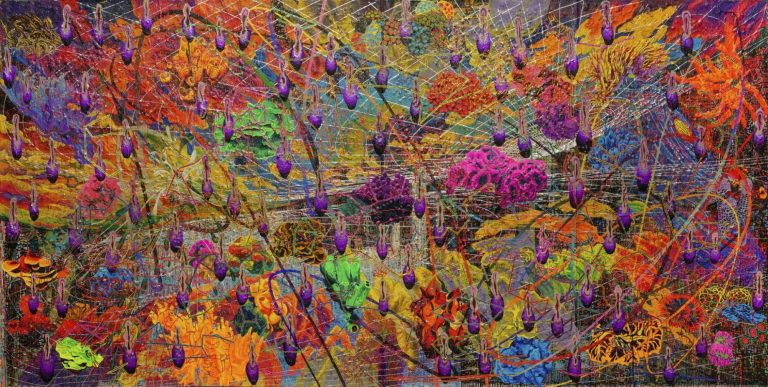We acknowledge the Traditional Owners of the land on which the Queensland Art Gallery | Gallery of Modern Art stands and recognise the creative contribution First Australians make to the art and culture of this country.

Thasnai Sethaseree / Thailand b.1968 / It’s unclearly clear, as yet incomplete (detail) 2017–21 / Paper collage, Buddhist monk robes, urethane, metal / Three parts: 400 x 800cm (each) / Commissioned for APT10. Purchased 2021 with funds from Metamorphic Foundation through the QAGOMA Foundation / Collection: QAGOMA / © Thasnai Sethaseree
Thasnai SethasereeIt’s unclearly clear, as yet incomplete 2017–2021
Not Currently on Display
It’s unclearly clear, as yet incomplete is the result of more than a year of the artist’s research and has taken almost three years to create. Comprising 30–40 layers of paper on material including stretched Buddhist monks’ robes, the triptych employs specific papers as content within compositions associated with structural problems in modern and contemporary Thailand, and beyond. Sethaseree uses scale and spectacle to mimic how aesthetics are used by Thai government and businesses to entertain and distract citizens from displeasure or discord at the state of national affairs.
Sethaseree’s triptych confronts what he considers the immorality of easily consumed spectacle (in a nation where royal and military pomp and ceremony are legendary) and hints at the trust in chance, profiteering and corruption that he finds in Thai modern and contemporary culture. Visual magnificence and splendour are warning signs for what lies beneath.
The initial layer of each work is a photograph of the skylines of three of Bangkok’s financial and business districts inverted, as if the artist hopes to reveal the underbelly of these districts. A variety of forms, defined by paper strips, are suspended on top. Images of cancer cells, scientific diagrams of tumours, prisms, images of the twilight sky, biological forms, lava flow, ghosts and skulls, ocean creatures, perspective images, and sky maps from the date of military coups are layered together. The latter — maps charting the stars on the dates chosen for political disruption — reflects the artist’s critique of the inconsistent relationship with belief systems and ethics he observes in Thailand’s leaders, whose decisions often rely on irrational omens for success.
A teacher and artist in Chiang Mai, Thasnai Sethaseree has been known for paintings that generate a play between foreground and background and require a physical relationship with the viewer. Sethaseree is interested in how power and seduction fold into state and commercial imagery — particularly in his homeland, Thailand — and his practice investigates the relation of images to political projects dating from the Cold War onwards.
His large-scale works are distinguished by their iconography and the substantial collaging of cut or shredded coloured paper, a style based on a traditional Thai paper-cutting technique, and which has been connected to Northern Thai Lanna weaving in its vibrancy, colour and use for ritual and celebration. Sethaseree uses this technique to convey his interests in socio-political histories that continue to have influence in the current day. These interests relate to the authoritative use of imagery in Thailand from the adoption of photography by the elite in the mid-nineteenth century through to the dominance of commodity culture from the period of the 1958–73 economic restructuring policy. For Setharesee, these factors have contributed to a corruption of ‘Thainess’, the warping of nationalist imagery in which daily life, commerce, Buddhism and culture are reworked for state, military and/or corporate ends far from democracy or egalitarianism.